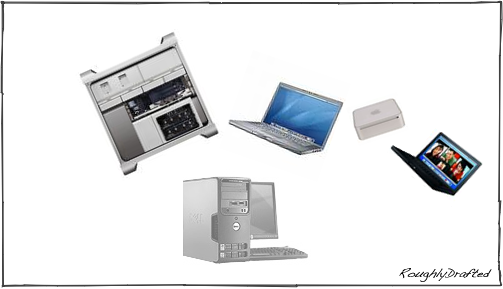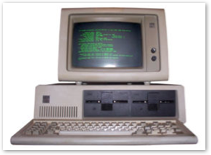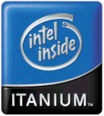





Apple has leapt a generation ahead of other PC makers in adopting Intel's modern EFI in its new new Intel Macs. An earlier article, Imaging MacBooks: Understanding MBR, APM, & GPT, introduced the idea of what's different between the BIOS in today's PCs and the new EFI in tomorrow's. Here's a more in depth look at what these differences mean, particularly for users of interested in using Apple hardware to run both Mac OS X and Windows.
The Seamless Move from PowerPC to Intel
Prior to the latest series of Intel Macs released this year, Apple had been using Open Firmware and their own proprietary disk partitioning system called APM. The new Intel Macs can read, but not boot, from existing APM drives. PowerPC Macs running Mac OS X 10.4.2 or later can read, but not boot, from GPT formatted disks.
Tiger is currently not Universal, so a Mac OS X boot disk has to be Intel or PowerPC specific. Therefore, the ability to boot both Mac architectures from the same type of disk isn't very important.
With Leopard, Apple will release one version of Mac OS X that installs and runs on both PowerPC and Intel Macs. After delivering Leopard, Apple will likely release new firmware for Intel Macs that removes any limitations from booting from the APM drives created by PowerPC Macs. This will once again allow a single drive to boot any Mac computer. It’s also possible, but more unlikely, that Apple will allow PowerPC Macs to boot from GPT drives.
 Of course, Apple's Universal Binary architecture already allows application developers to ship their applications in a processor agnostic bundle that "just works" regardless of the underlying processor.
Of course, Apple's Universal Binary architecture already allows application developers to ship their applications in a processor agnostic bundle that "just works" regardless of the underlying processor.Actually, it isn't wholly impossible for Intel Macs to boot from APM hard disks, but it is unsupported. Intel Macs can boot from APM installer DVDs, and astute users have found ways to trick Intel Macs into booting from APM hard drives. However, the current lack of a Universal OS makes this more confusing than useful for most people.
Since old and new Macs can at least read each other's disks, there is no real problem. The APM booting limitations on Intel Macs are artificially imposed by Apple to prevent exposing users to unnecessary complication.
This seamless interoperability among old and new Macs is a bit more refined than the jump from standard PCs to the new Intel Macs, as anyone experimenting with Boot Camp has discovered. Apple’s new Intel Macs are PCs, but they are a generation ahead of other vendor’s PCs.
BIOS PCs, Intel Macs, and EFI
Beyond the differing disk formats used by Macs (HFS+) and Windows (NTFS or FAT), there is also an issue of the partitioning system, which is linked to the platform's firmware. Open Firmware PowerPC Macs, as noted above, used APM. BIOS-based PCs have always used MBR. EFI introduced new format called GPT.

All PC hardware descending from the 1981 IBM PC have continued to use the creaky, old, and simplistic BIOS for firmware-level device management. BIOS in turn is tied to MBR, the archaic partitioning system that is inflexible, insecure, and inherently limited by its obsolete design.
In order to bring the modern features of Macs’ Open Firmware to the PC world, Intel introduced EFI as a modern architecture for a new breed of PCs.
Originally, EFI was designed to compliment the IA64 Itanium platform, the entirely new, 64-bit processor architecture that Intel, along with the rest of the industry, hoped would supplant the aging x86 Pentium platform.
Apple’s Lead in EFI
Itanium and EFI didn't exactly work out at Intel had hoped. However, Apple's adoption of EFI in their new Intel Macs will likely force PC makers to get on the stick and find ways to catch up to Apple's lead.
The exact same scenario occurred with Intel's USB technology. PC makers dragged their feet, making dysfunctional attempts to add USB ports on their machines that often didn't even work properly, while Microsoft similarly failed to introduce timely software support for USB in Windows. It was a catch-22 of foot dragging.
It wasn't until Apple mandated USB as the new way to use peripherals on the iMac that USB adoption really began to gain traction. If Apple hadn’t decisively stepped into the future in 1998, BIOS PCs would undoubtedly still use a mess of PS/2, RS-232 serial, and Centronics parallel ports. Most still do, in 2006.
It took nearly a decade for even the top tier PC makers such as Dell to start delivering USB machines with USB keyboards and mice! How long will it take Microsoft and the BIOS PC makers to get on board with EFI? Who knows, but Apple is using their sloth to its own advantage. EFI helps to differentiate Apple's hardware as a higher value, higher quality PC, without requiring a higher price.
How EFI's GPT Partitions Work
EFI is basically Intel's own re-implementation of Open Firmware, with extra features to provide backward support for MBR. MBR is the ancient system used by BIOS PCs to record where partitions are on a disk. An MBR looks like this:

For EFI, Intel designed a new partition table with room for far more than MBR's four primary, bootable partitions. The standard EFI partition table allows for 128. Each partition is identified by two GUIDs: the first identifies the type of partition (such as Mac HFS, or PC Data), the second is a serial number for that specific partition.

GPT also duplicates its partition table, keeping a secondary backup on the end of the disk. This allows the drive to remain readable even if the main critical partition information is damaged or corrupted. Both tables also have a calculated checksum, so the system can detect a corrupt file partition index, and know to use the duplicate. That protects and enhances the resiliency of GPT's disk index integrity.

In order to maintain backward compatibility with MBR, GPT creates a protective MBR placeholder. This prevents disk utilities that assume the use of MBR conventions from overwriting the GPT information on a disk.
If Windows utilities are used to change partitions on a GPT disk, they only see the dummy MBR, and any changes they make will only be reflected in Windows (or other legacy applications). They can not delete Mac partitions, but they can remove its records from the MBR. Once that happens, Windows won't see the Mac disk anymore.

GPT-aware utilities that make changes to the partition also update the dummy MBR information. This enables legacy applications, including Windows XP, to find the correct disk information.
GPT and Windows
The common retail version of Windows XP does not support using GPT volumes; they do appear as normal drives however, because Windows reads the protective MBR and thinks it is a regular 1981-style MBR disk. If you pull the hard drive from a Boot Camp Mac and put it into a PC, you will be able to read the Windows partition. The Apple partition will appear as an unusable drive.
PCs will not be able to successfully boot a Windows install created on a Mac however, because Windows sets up specific hardware drivers. A Windows boot disk is generally not transferable unless it is moved between identical hardware. In contrast, most Mac boot disks can generally be used to boot any Mac.
Microsoft's 64-bit Itanium version of Windows boots from and uses GPT volumes, because the reference platform for Itanium uses EFI. Itanium (IA-64), is not at all compatible with x86 (IA-32) BIOS PCs however. Itanium is an entirely different platform.
Itanium vs. PowerPC
Itanium was Intel's first stab at delivering a 64-bit processor for the PC world. It was hailed as the heir apparent of the x86, and the new architecture that everything was going to eventually adopt.
Compaq's Alpha processor, SGI's MIPS, and HP's PA-RISC were all sacrificed to make way for the promised new world of Itanium, and Itanium is what all the PC wags thought Apple needed to drop PowerPC in order to adopt. Fortunately, Apple didn't!
Intel needed to present Itanium as a direct competitor to PowerPC, which had been making Intel's x86 platform look rather long in the tooth. During the mid to late 90's, there was a flurry of excitement among PowerPC's AIM partners (Apple, IBM, and Motorola) that PowerPC would itself replace the x86 platform instead of Itanium. 

Motorola worked to port Windows NT to PowerPC, IBM ported OS/2, and Apple transitioned its 68k Macs. BeOS also planned to run on a common PowerPC platform, and NeXT made some progress toward porting their OS to PowerPC, before deciding to go software only.
In addition to PowerPC, Windows NT had originally been designed to also run on Alpha and MIPS processors. However, Microsoft couldn't manage to sustain delivering its applications across different platforms, and since everything apart from PowerPC was being liquidated to make way for Intel's Itanium, Microsoft dropped support for everything but x86 BIOS PCs, and planned to adopt Itanium when it arrived.
While PowerPC wasn't adopted the way its partners had hoped, Itanium ended up being an even bigger failure. Itanium didn't even get delivered until 2001, and by then it had missed out on the dotcom extravaganza that had served to float the tech industry through several bad ideas. Had Intel got it out the door earlier, they might have made bank.
Instead, Itanium was derided as the Itanic: it was hot, inefficient, expensive, had little custom software, and its ability to run x86 software in a compatibility mode turned out to be less impressive than everyone had expected.
The Itanium Killer
Itanium's fate was sealed when AMD, Intel's smaller rival, introduced 64-bit extensions to the existing 32-bit x86 processor architecture, which they called x86-64, and then AMD64.
It was both simpler and more backward compatible, and has become the de facto standard for 64-bit BIOS PCs. Intel was forced to humbly adopt AMD's implementation; Intel call their compatible version EM64T. This apparently stands for “Embarrassing Maneuver in 64-bit Technology.”
Microsoft refers to Intel's EM64T and AMD64 as x64. Versions of Windows that support x64 do not support booting from GPT, because x64, unlike Itanium (IA64), is built upon regular old BIOS PCs, just like all the other 32-bit, non-Apple PCs.
Windows, running on a x64 BIOS PC, can use GPT volumes however; it just can't boot from a GPT disk. This naturally creates some confusion.
Platforms and GPT Compatibility

Imaging and Disk Utilities for GPT Volumes
Apple provided Boot Camp as an easy way to prepare a Mac drive for booting both Mac OS X and Windows XP, as outlined in How Boot Camp Works.
Currently, there are no easy-to-use disk utilities that can non-destructively change GPT partitions after they have been created. Apple's Disk Utility can create GPT partitions and make room for Windows installs, but it can not change partition structures without wiping out the contents of the drive.
Disk Utility can also not be used to image NTFS disks because it can not write NTFS. Neither can Carbon Copy Cloner or SuperDuper; they only work on Mac volumes. 

Mike Bombich, the creator of Carbon Copy Cloner, has created an easy to use imaging utility called NetRestore. It is built upon Apple Software Restore, and bundles support for NTFS imaging based upon ntfsprogs, an open source Linux project working to build disk utilities for Windows NTFS volumes.
Window's NTFS is a complex file system, and support for writing to it outside of Windows has not yet been fully developed. Linux projects have been working to deliver interoperability with NTFS, and as they make progress, their efforts have been added to Mac OS X. While full support isn't yet available, ntfsprogs enables NetRestore to successfully image NTFS volumes.
That means IT administrators can now clone Windows partitions to quickly set up multiple machines. In other words, they can quickly roll out MacBooks as Windows laptops. I'll show how in my next article.

| | Comment Preview
 Read more about:
Read more about:

 Send |
Send |

 Subscribe |
Subscribe |
 Del.icio.us |
Del.icio.us |
 Digg |
Digg |
 Furl |
Furl |
 Reddit |
Reddit |
 Technorati
Technorati
Click one of the links above to display related articles on this page.
How Apple’s Firmware Leapfrogs BIOS PCs
Sunday, August 20, 2006





Ad










